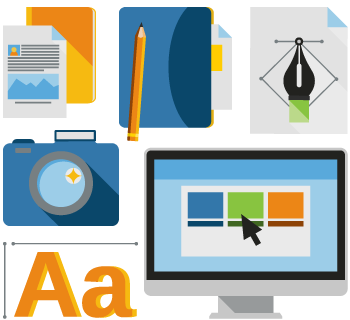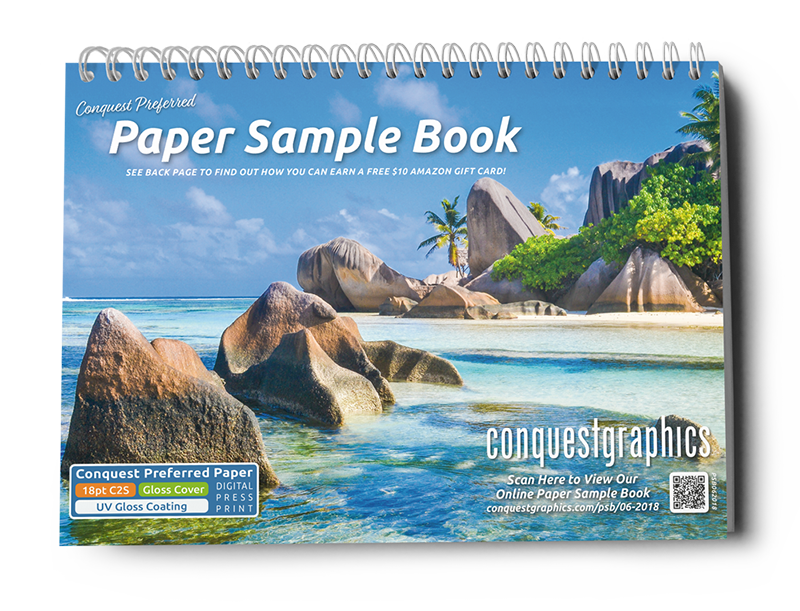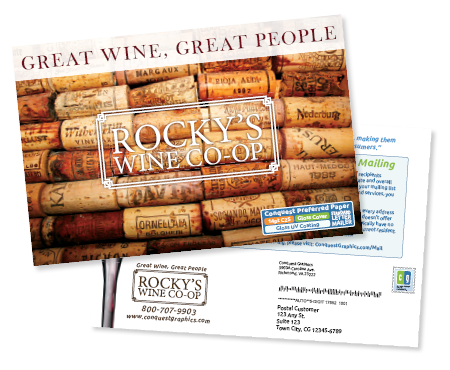
In 2022, you have to plan ahead for your marketing campaigns more than ever before to assure a timely, accurate and successful campaign.
We went into detail on what you need to know about the paper industry in 2022, along with the reasons and solutions for the increase in paper costs. One of the solutions we mentioned was to plan ahead so you can take advantage of the current lower paper prices, and the lower costs available with longer turnarounds. Saving money isn’t the only benefit of planning ahead though. With supply chain constraints and delays, along with extended flex days with turnarounds, planning ensures that your marketing campaign is delivered on time as well.
So, let's take an in-depth look into every step that goes into your print advertising project and some tips on how you can avoid the struggles involving delays and save some money in the process.
Step 1: Planning Your Campaign
Does your company regularly take advantage of print or direct mail? Are you tabling the idea to utilize the power of print advertisements? Do you send out holiday greeting cards or calendars? Do you have a trade show or event coming up? Or do you simply have so much on your plate that you aren’t concerned about finalizing the details to that catalog campaign you are planning to launch next month?

Truth is, you need to get started on your planning now or as soon as you are able, especially with the current challenges. This is because with everything going on in the paper industry and shipping delays, it's important to make sure your planning is prepared, and you have developed the right strategy for your marketing goals. Any mistake in the planning period will negatively affect the next steps of your print marketing project.
Planning includes answering the following questions:
- Who will your audience be?
- What will your marketing message be/what are you promoting?
- What material and size will be the most effective for your campaign?
- Will you use a multi-media campaign like email and postcard marketing?
- When do you want your campaign to launch?
- Are you handing out your materials or utilizing direct mail marketing?
The details in your planning need to be more thought-out and precise now more than ever and planned out earlier than you usually would. This is because with the high demand for paper, high shipping costs, shipping delays and delays in trying to balance these changes, there isn’t much cushion for unsure ideas or last-minute changes.
For example, if you are planning to utilize a multi-channel marketing campaign, like an email and postcard campaign, you need to allow enough time for your postcards to be printed and mailed so that when they reach your audience, they line up with your email campaign.
Step 2: Designing Your Materials
Don’t just double-check for any typos or grammatical errors. Triple check. And then ask a friend or co-worker to check. And then check again. This goes for image placement, the correct colors, the right bleed and margin, and any other element that is within the design of your printed materials.

There is no room for error in today's world, and to get your valuable marketing message in the hands of your audience when you need them to, you can’t trust that your first and second look over of your design was accurate.
When designing your marketing materials keep the following in mind:
- Your document page size is equal to the finished trim size and has 1/8” (.125”) bleeds on all sides of the document. You can utilize a design template to ensure the proper layout.
- Your images need to be in high-resolution, at least 300 dpi, and 1200 dpi for line art or non-photo-graphic images.
- Make sure images, logos and all design elements are converted to the CMYK color model.
- Whether you use Adobe InDesign or Microsoft Word as your design platform, make sure that your final formats are generated as PDFs.
Although designing your own materials or having an internal team member design your materials is cheaper, it can be beneficial to utilize your printer’s design services to ensure every design element is set up perfectly for the press and to avoid any errors that could cause further delay.
Step 3: Choosing a Turnaround
Turnaround time begins the day you approve your proof and ends the day your job ships or is ready to be picked up. For example, and relatively speaking, if your project's turnaround was 3 days, and you approved your proof on a Monday, your project would ship or would be ready to be picked up on Thursday.

Within each product configurator, you’ll see a drop-down box for you to choose a turnaround time. These turnarounds include flex days which is why you see 4-6 days or 7-10 days. This allows a cushion for any delays that may occur. These delays happen even during unchallenging times, but it is important to note that during messy times, like the challenges the paper industry is facing, it is important to not rely on that earliest day. Although printers, like Conquest Graphics, will do everything in their power to achieve that earliest turnaround, there isn’t any guarantee, and you need to account for this even in your planning stage.
Because you have planned ahead you have given your marketing project enough time to be created with a longer turnaround. Which can also save you a tremendous amount of money. So, even when the paper industry returns to normal, it doesn’t hurt to plan for a longer turnaround.
Longer turnarounds allow you to save money because it gives the production team longer time to produce your project. Be sure to choose the longest turnaround that fits your project or let your representative know that if you have planned ahead, a longer turnaround is acceptable. Note that because USPS is facing delays as well—due to a few reasons including increased shipments—if you are mailing or shipping your materials, be sure to account for a longer delivery time as well. This may result in needing a quicker turnaround which means, yet again, planning ahead is very important.
Step 4: Quoting Your Projects

After you have planned your marketing campaign out and designed your materials, it’s time to quote your project. Many printers, like Conquest Graphics, make it easy to simply input the specifications of your printed project, upload artwork and mailing information, and place your order online. However, it can be extremely beneficial to request a quote from your representative or by contacting customerservice@ConquestGraphics.com. This is because when they build you a quote, they can help you avoid any errors along the way and recommend any details that may be better suited for your budget and marketing goal. Of course, custom quotes are needed for non-standard sizes, binding methods, paper selections, etc. it is still a good idea to work with a representative to build your quote for standard specifications as well.
Step 5: Sending to Estimating (if necessary)
Many printers have products that are pre-priced—this includes standard sizes, paper stocks, and materials—or ready to go with pricing in place in your company’s online Ordering Portal. However, custom projects get sent to an estimating team before a proof is sent to you so that you can receive the most accurate quote possible. This includes the price on shipping and your custom specifications, like specialty paper or sizes, special binding methods, and more.
This inevitably delays the process of your entire project because the estimating team needs to work on preparing an accurate price and delivery time. And if when they send you your custom quote, you need to adjust any specifications, it then goes back to the estimating team. This can become a time-consuming back and forth process that delays your turnaround and delivery time. To avoid these delays, it’s a good idea to stick with your printer's pre-priced materials. However, if this is not an option, make sure that you have given yourself enough time to account for the estimating process and that you communicate with your representative and estimating team as quickly as you are able. Include any notes and the exact specifications of your project that you need when communicating. This is another reason why working with a representative is beneficial. They can help you save some time by working with you to make sure everything is exactly the way you need them.
Step 6: Approving Your Proof
There are two kinds of proofs you can request: a contract proof (a physical proof that is mailed to you) and an electronic proof which is a PDF version of your printed project.

With today's technology and color matching capabilities, electronic proofs are highly recommended as they are sent via email fairly quickly (typically 2-8 business hours after you have uploaded your files.) If you are interested in a contract proof, you will need to plan for extra time as your printed proof will need to be produced and then mailed to you and then back to your printer which delays the time of your final project's arrival. With normal circumstances, the goal is to print and ship the contract proof the same business day, however, with the challenges affecting USPS and the paper industry, the process of your contract proof can become delayed.
When it comes to approving your proof, don’t leave anything unchecked. Just like your design, you need to triple-check and check again. Your printer will typically inform you of image resolution and size issues. However, it is on you to make sure the layout and anything else that is critical to the overall goal of your design and material is correct. You can of course consult your printer’s design team for any help, but it is still important to check every detail within your proof before approving to avoid extra charges and any further delays. If an error is found, the error then must be fixed, sent to your printer and then another proof is sent which is also be a time-consuming process.
Although it is highly important to check that your proof is accurate, it is also important that you approve your proof as soon as possible. For example, if you have chosen a 5-7 business day turnaround time and your electronic proof is sent to you on a Tuesday, but you do not approve your proof until Thursday, your turnaround time will not begin until Friday. If you would have approved your proof the Tuesday it was sent to you, your turnaround time could have begun on Wednesday.
Step 7: Waiting on Special Materials
Like step 5, this step is only for projects with custom specifications. If your project includes a specialty paper that is not offered as an in-house paper stock, your printer will need to order it which takes time. Ordering specialty paper has always added time to projects but with paper inventory issues, this process has become longer than usual which delays your project further.

If it isn’t critical that your project is printed on specialty paper, you should choose a standard paper offered by your printer. This is because many printers, like Conquest Graphics, maintain a large inventory of their high-quality, standard, or preferred stocks. This means you don’t have to wait for your printer to order and receive the specialty stocks and printing your project can begin much sooner. If you aren’t sure a preferred stock would deliver the right message for your marketing project, check to see if your printer offers a free paper sample booklet like Conquest Graphics does. A booklet like this includes your printer’s most popular and preferred papers so you can see and feel the quality for yourself.
Step 8: Printing Your Project
Once you have approved your proof your project is moved to production where it is printed and prepared to be mailed or shipped.
For many reasons, including trade shows and events being back up and running, and more businesses discovering the benefits of print and direct mail, and other reasons for an influx in printing needs, more and more projects are being produced. This means printer’s production teams are producing projects at a rapid speed enforcing the need for adjusted turnarounds.
With busy presses, it’s important that within every step above, you leave no room for error. Go through every step with a fine-tooth comb and magnifying glass. The production team will always be sure to print and prepare your projects as quickly as possible but if there are any issues that you made prior that aren’t noticed until production is complete, your project will be delayed further for a reprint, and extra charges will be applied.
Step 9: Mailing and Shipping Your Materials
Freight and shipping delays along with cost increases are at an all-time high right now. There are capacity and shipping container shortages and an increase in consumer spending which are all causing these delays and price increases. Also, extended delays are being made to ensure a cheaper and more reliable system according to the USPS. For example, previously you could have expected a 1-3 day delivery window, whereas now you can expect a 1–5 day delivery window.

This means, if you are promoting a big sale in October, you shouldn't wait to advertise a week prior. Instead, try to advertise at least 2 weeks prior, so that if delays occur, your marketing materials will arrive on time for the sale instead of later.
If you are concerned that an early advertisement may generate fewer responses, this is the perfect time to utilize a multi-media or multi-drop campaign. A multi-media campaign will allow you to promote your message on multiple channels while a multi-drop campaign will get your marketing message in the hands of your audience multiple times to build better brand recall and greater responses.
Step 10: Your Materials Have Arrived
Your materials are officially in your hands or in the mailboxes of your audience. It may have seemed like a tedious process, but when it comes to your marketing, especially in today's world, it is important to make sure everything is set up perfectly to achieve your marketing goals and to avoid any delays. And once your campaign has officially launched you will be successfully ready to gain incredible results like better brand recognition, increased ROI, and more.
With the challenges affecting our industry, there isn’t room for any errors. That’s why we, at Conquest Graphics, are here to help you every step of the way to ensure that any inevitable delays that do occur, are minimal. We understand that your marketing campaign is very valuable and the benefits you gain are more successful than any other strategy offered by digital marketing companies, that’s why we want you to be aware of these challenges so you can prepare for a timely, accurate, and successful marketing campaign.
Start Planning Today!









